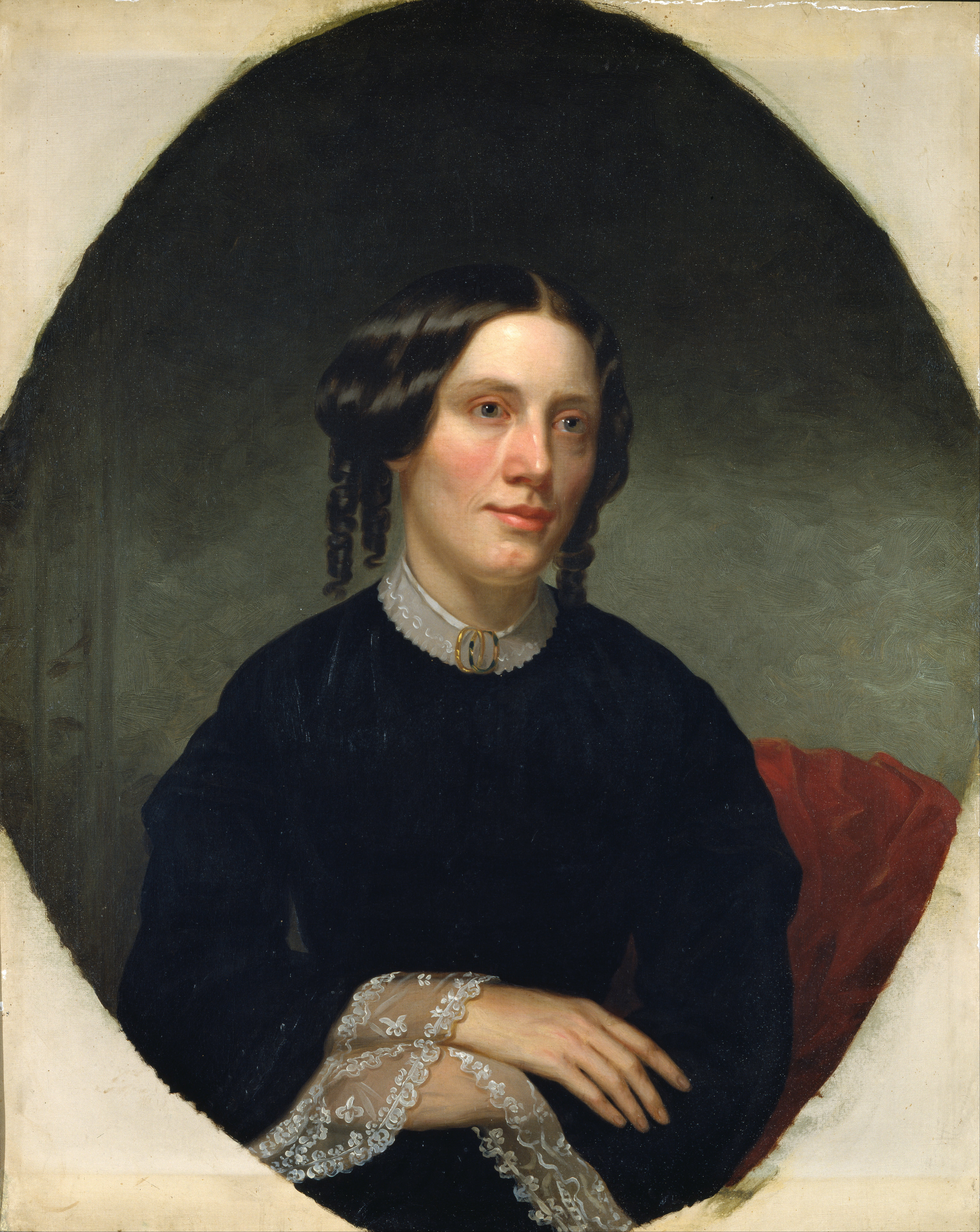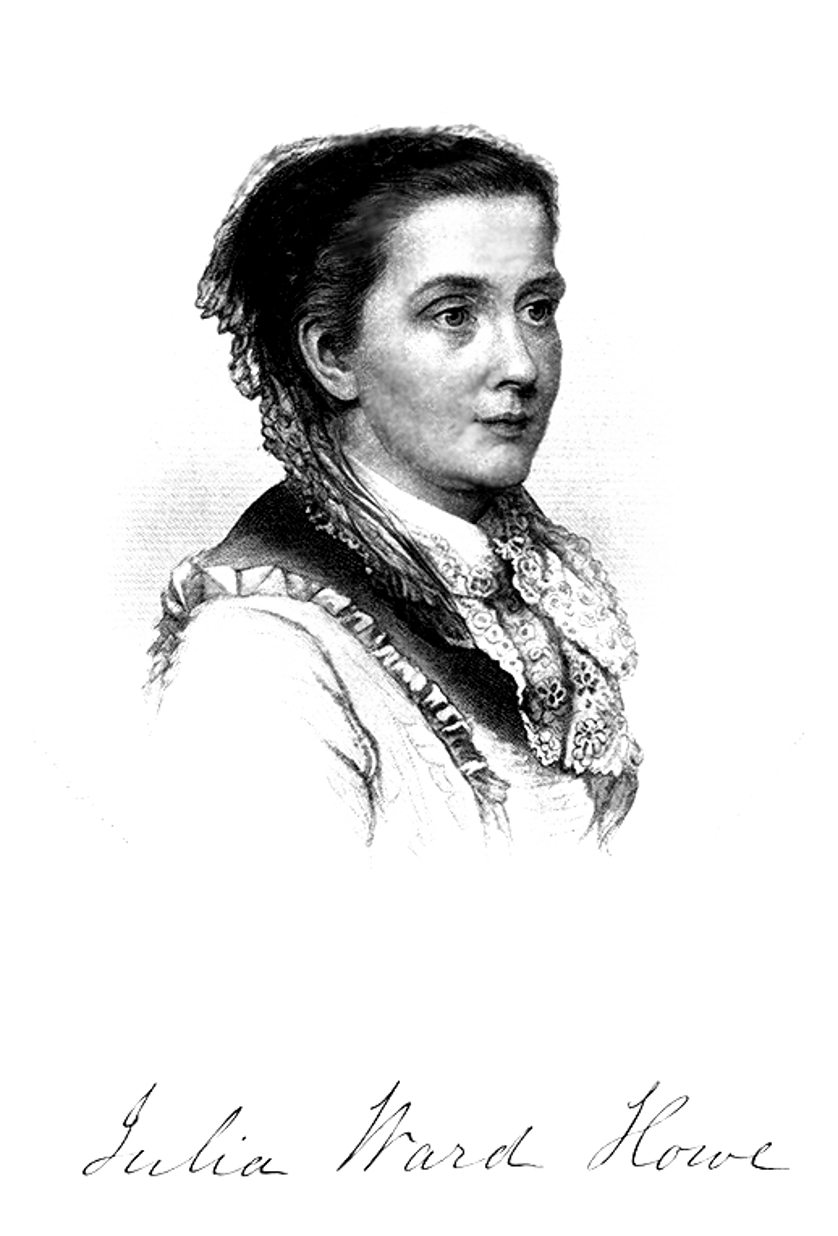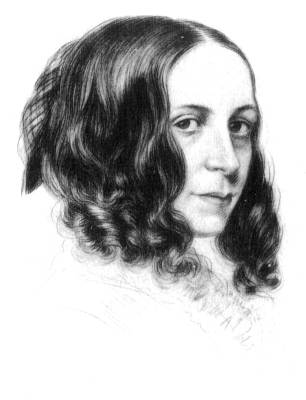|
Susan Huntington Gilbert Dickinson
Susan Huntington Gilbert Dickinson (December 19, 1830 – May 12, 1913) was an American writer, poet, traveler, and editor. She was the sister-in-law of poet Emily Dickinson. Life Susan Huntington Gilbert was born December 19, 1830, in Old Deerfield, Massachusetts, the youngest of six children born to Thomas and Harriet (Arms) Gilbert. She was orphaned by the time she was eleven years old, after her mother died in 1837 and her father in 1841. Gilbert lived with her aunt, Sophia (Arms) Van Vranken, in Geneva, New York, until the late 1840s. She then lived in Amherst, Massachusetts, with her sister Harriet and brother-in-law William Cutler. In Amherst, she attended Utica Female Academy and Amherst Academy for one semester in the fall of 1847. In 1853, she was engaged to Austin Dickinson. Their marriage in the Van Vranken home on July 1, 1856, was "a quiet wedding" with "very few friends and nly Susan'sbrothers & sisters, a little cake–a little ice cream." Although the youn ... [...More Info...] [...Related Items...] OR: [Wikipedia] [Google] [Baidu] |
Old Deerfield, Massachusetts
Historic Deerfield is a museum dedicated to the heritage and preservation of Deerfield, Massachusetts, and history of the Connecticut River Valley. Its historic houses, museums, and programs provide visitors with an understanding of New England's historic villages and countryside. It is located in the village of Old Deerfield which has been designated a National Historic Landmark District (as the Old Deerfield Historic District), and is listed on the National Register of Historic Places. The museum also hosts the Dublin Seminar for New England Folklife. Sites Eleven historic house museums are located in Historic Deerfield. Most are viewed on guided tours. A modern museum and a visitors center are part of the complex. The museum offers special exhibitions, family activities, workshops and seminars on historic subjects, and a gift shop. The Deerfield Inn is available for visitors. * Ashley House is the 1734 home of Deerfield's 18th-century minister, with furnishings of the Co ... [...More Info...] [...Related Items...] OR: [Wikipedia] [Google] [Baidu] |
Violet (plant)
''Viola'' is a genus of flowering plants in the violet family Violaceae. It is the largest genus in the family, containing between 525 and 600 species. Most species are found in the temperate Northern Hemisphere; however, some are also found in widely divergent areas such as Hawaii, Australasia, and the Andes. Some ''Viola'' species are perennial plants, some are annual plants, and a few are small shrubs. Many species, varieties and cultivars are grown in gardens for their ornamental flowers. In horticulture the term pansy is normally used for those multi-colored, large-flowered cultivars which are raised annually or biennially from seed and used extensively in bedding. The terms viola and violet are normally reserved for small-flowered annuals or perennials, including the wild species. Description Annual or perennial caulescent or acaulescent (with or without a visible plant stem above the ground) herbs, shrubs or very rarely treelets. In acaulescent taxa the foliage and flower ... [...More Info...] [...Related Items...] OR: [Wikipedia] [Google] [Baidu] |
One Asked, When Was The Grief?
1 (one, unit, unity) is a number representing a single or the only entity. 1 is also a numerical digit and represents a single unit of counting or measurement. For example, a line segment of ''unit length'' is a line segment of length 1. In conventions of sign where zero is considered neither positive nor negative, 1 is the first and smallest positive integer. It is also sometimes considered the first of the infinite sequence of natural numbers, followed by 2, although by other definitions 1 is the second natural number, following 0. The fundamental mathematical property of 1 is to be a multiplicative identity, meaning that any number multiplied by 1 equals the same number. Most if not all properties of 1 can be deduced from this. In advanced mathematics, a multiplicative identity is often denoted 1, even if it is not a number. 1 is by convention not considered a prime number; this was not universally accepted until the mid-20th century. Additionally, 1 is ... [...More Info...] [...Related Items...] OR: [Wikipedia] [Google] [Baidu] |
Frederick Olmsted
Frederick Law Olmsted (April 26, 1822August 28, 1903) was an American landscape architect, journalist, social critic, and public administrator. He is considered to be the father of landscape architecture in the USA. Olmsted was famous for co-designing many well-known urban parks with his partner Calvert Vaux. Olmsted and Vaux's first project was Central Park, which led to many other urban park designs, including Prospect Park in what was then the City of Brooklyn (now the Borough of Brooklyn in New York City) and Cadwalader Park in Trenton, New Jersey. He headed the preeminent landscape architecture and planning consultancy of late nineteenth-century America, which was carried on and expanded by his sons, Frederick Jr. and John C., under the name Olmsted Brothers. Other projects that Olmsted was involved in include the country's first and oldest coordinated system of public parks and parkways in Buffalo, New York; the country's oldest state park, the Niagara Reservation in ... [...More Info...] [...Related Items...] OR: [Wikipedia] [Google] [Baidu] |
Wendell Phillips
Wendell Phillips (November 29, 1811 – February 2, 1884) was an American abolitionist, advocate for Native Americans, orator, and attorney. According to George Lewis Ruffin, a Black attorney, Phillips was seen by many Blacks as "the one white American wholly color-blind and free from race prejudice". According to another Black attorney, Archibald Grimké, as an abolitionist leader he is ahead of William Lloyd Garrison and Charles Sumner. From 1850 to 1865 he was the "preëminent figure" in American abolitionism. Early life and education Phillips was born in Boston, Massachusetts, on November 29, 1811, to Sarah Walley and John Phillips, a wealthy lawyer, politician, and philanthropist, who was the first mayor of Boston."A Famous Career," ''Reading [...More Info...] [...Related Items...] OR: [Wikipedia] [Google] [Baidu] |
Harriet Beecher Stowe
Harriet Elisabeth Beecher Stowe (; June 14, 1811 – July 1, 1896) was an American author and abolitionist. She came from the religious Beecher family and became best known for her novel ''Uncle Tom's Cabin'' (1852), which depicts the harsh conditions experienced by enslaved African Americans. The book reached an audience of millions as a novel and play, and became influential in the United States and in Great Britain, energizing anti-slavery forces in the American North, while provoking widespread anger in the South. Stowe wrote 30 books, including novels, three travel memoirs, and collections of articles and letters. She was influential both for her writings and for her public stances and debates on social issues of the day. Life and work Harriet Elisabeth Beecher was born in Litchfield, Connecticut on June 14, 1811.McFarland, Philip. ''Loves of Harriet Beecher Stowe''. New York: Grove Press, 2007: 112. She was the sixth of 11 children born to outspoken Calvinist preache ... [...More Info...] [...Related Items...] OR: [Wikipedia] [Google] [Baidu] |
Ralph Waldo Emerson
Ralph Waldo Emerson (May 25, 1803April 27, 1882), who went by his middle name Waldo, was an American essayist, lecturer, philosopher, abolitionist, and poet who led the transcendentalist movement of the mid-19th century. He was seen as a champion of individualism and a prescient critic of the countervailing pressures of society, and his ideology was disseminated through dozens of published essays and more than 1,500 public lectures across the United States. Emerson gradually moved away from the religious and social beliefs of his contemporaries, formulating and expressing the philosophy of transcendentalism in his 1836 essay "Nature". Following this work, he gave a speech entitled "The American Scholar" in 1837, which Oliver Wendell Holmes Sr. considered to be America's "intellectual Declaration of Independence."Richardson, p. 263. Emerson wrote most of his important essays as lectures first and then revised them for print. His first two collections of essays, '' Essays: Firs ... [...More Info...] [...Related Items...] OR: [Wikipedia] [Google] [Baidu] |
Thomas Carlyle
Thomas Carlyle (4 December 17955 February 1881) was a Scottish essayist, historian and philosopher. A leading writer of the Victorian era, he exerted a profound influence on 19th-century art, literature and philosophy. Born in Ecclefechan, Dumfriesshire, Carlyle attended the University of Edinburgh where he excelled in mathematics, inventing the Carlyle circle. After finishing the arts course, he prepared to become a minister in the Burgher Church while working as a schoolmaster. He quit these and several other endeavours before settling on literature, writing for the ''Edinburgh Encyclopædia'' and working as a translator. He found initial success as a disseminator of German literature, then little-known to English readers, through his translations, his ''Life of'' ''Friedrich Schiller'' (1825), and his review essays for various journals. His first major work was a novel entitled ''Sartor Resartus'' (1833–34). After relocating to London, he became famous with his ''French Rev ... [...More Info...] [...Related Items...] OR: [Wikipedia] [Google] [Baidu] |
Julia Ward Howe
Julia Ward Howe (; May 27, 1819 – October 17, 1910) was an American author and poet, known for writing the "Battle Hymn of the Republic" and the original 1870 pacifist Mother's Day Proclamation. She was also an advocate for abolitionism and a social activist, particularly for women's suffrage. Early life and education Julia Ward was born in New York City. She was the fourth of seven children. Her father Samuel Ward III was a Wall Street stockbroker, banker, and strict Calvinist Episcopalian. Her mother was the poet Julia Rush Cutler Ward, related to Francis Marion, the "Swamp Fox" of the American Revolution. She died during childbirth when Howe was five. Howe was educated by private tutors and schools for young ladies until she was sixteen. Her eldest brother, Samuel Cutler Ward, traveled in Europe and brought home a private library. She had access to these books, many contradicting the Calvinistic view. She became well-read, though social as well as scholarly. She met ... [...More Info...] [...Related Items...] OR: [Wikipedia] [Google] [Baidu] |
Thomas De Quincey
Thomas Penson De Quincey (; 15 August 17858 December 1859) was an English writer, essayist, and literary critic, best known for his ''Confessions of an English Opium-Eater'' (1821). Many scholars suggest that in publishing this work De Quincey inaugurated the tradition of addiction literature in the West. Life and work Child and student Thomas Penson De Quincey was born at 86 Cross Street, Manchester, Lancashire. His father, a successful merchant with an interest in literature, died when De Quincey was quite young. Soon after his birth, the family went to ''The Farm'' and then later to Greenheys, a larger country house in Chorlton-on-Medlock near Manchester. In 1796, three years after the death of his father, Thomas Quincey, his mother – the erstwhile Elizabeth Penson – took the name "De Quincey".Morrison, Robert. "Thomas De Quincey: Chronology" TDQ Homepage. Kingston: Queen's University, 2013. That same year, De Quincey's mother moved to Bath and enrolled him at King E ... [...More Info...] [...Related Items...] OR: [Wikipedia] [Google] [Baidu] |
Robert Browning
Robert Browning (7 May 1812 – 12 December 1889) was an English poet and playwright whose dramatic monologues put him high among the Victorian poets. He was noted for irony, characterization, dark humour, social commentary, historical settings and challenging vocabulary and syntax. His early long poems ''Pauline'' (1833) and ''Paracelsus'' (1835) were acclaimed, but his reputation dwindled for a time – his 1840 poem ''Sordello'' was seen as wilfully obscure – and took over a decade to recover, by which time he had moved from Shelleyan forms to a more personal style. In 1846 he married fellow poet Elizabeth Barrett and moved to Italy. By her death in 1861 he had published the collection ''Men and Women'' (1855). His ''Dramatis Personae'' (1864) and book-length epic poem ''The Ring and the Book'' (1868–1869) made him a leading poet. By his death in 1889 he was seen as a sage and philosopher-poet who had fed into Victorian social and political discourse. Societies for ... [...More Info...] [...Related Items...] OR: [Wikipedia] [Google] [Baidu] |
Elizabeth Barrett Browning
Elizabeth Barrett Browning (née Moulton-Barrett; 6 March 1806 – 29 June 1861) was an English poet of the Victorian era, popular in Britain and the United States during her lifetime. Born in County Durham, the eldest of 12 children, Elizabeth Barrett wrote poetry from the age of eleven. Her mother's collection of her poems forms one of the largest extant collections of juvenilia by any English writer. At 15, she became ill, suffering intense head and spinal pain for the rest of her life. Later in life, she also developed lung problems, possibly tuberculosis. She took laudanum for the pain from an early age, which is likely to have contributed to her frail health. In the 1840s, Elizabeth was introduced to literary society through her distant cousin and patron John Kenyon. Her first adult collection of poems was published in 1838, and she wrote prolifically between 1841 and 1844, producing poetry, translation, and prose. She campaigned for the abolition of slavery, and her w ... [...More Info...] [...Related Items...] OR: [Wikipedia] [Google] [Baidu] |




.jpg)






